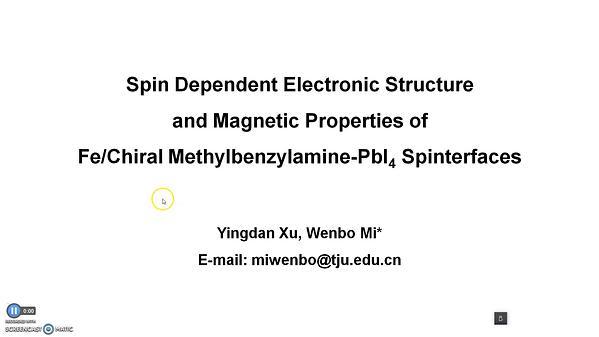Would you like to see your presentation here, made available to a global audience of researchers?
Add your own presentation or have us affordably record your next conference.
Orthoferrites (REFeO3) containing rare-earth (RE) elements are 3D antiferromagnets (AFM) that exhibit characteristic weak ferromagnetism originating due to slight canting of the spin moments and display a rich variety of spin reorientation transitions in the magnetic field (H)-temperature (T) parameter space (1, 2). We present spin Hall magnetoresistance (SMR) studies (3) on a b-plate (ac-plane) of crystalline Ho0.5Dy0.5FeO3│Pt hybrid at various T in the range, 11 to 300 K. In the room temperature Γ4(Gx, Ay, Fz) phase, the switching between two degenerate domains, Γ4(+Gx, +Fz) and Γ4(-Gx, -Fz) occurs at fields above a critical value, Hc ≈ 713 Oe. Under H > Hc, the angular dependence of SMR (α-scan) in the Γ4(Gx, Ay, Fz) phase yielded a highly skewed curve with a sharp change (sign-reversal) along with a rotational hysteresis around a-axis. This hysteresis decreases with an increase in H (Fig.1). Notably, at H < Hc, the α-scan measurements on the single domain, Γ4(± Gx, ± Fz) exhibited an anomalous sinusoidal signal of periodicity 360 deg. Low-T SMR curves (H = 2.4 kOe), showed a systematic narrowing of the hysteresis (down to 150 K) and a gradual reduction in the skewness (150 to 52 K), suggesting weakening of the anisotropy possibly due to the T-evolution of Fe-RE exchange coupling. Below 25 K, the SMR modulation showed an abrupt change around the c-axis, marking the presence of Γ2(Fx,Cy,Gz) phase. We have employed a simple Hamiltonian and computed SMR to examine the observed skewed SMR modulation. In summary, SMR is found to be an effective tool to probe magnetic anisotropy as well as a spin reorientation in Ho0.5Dy0.5FeO3. Our spin-transport study highlights the potential of Ho0.5Dy0.5FeO3 for future AFM spintronic devices.
References:
(1) T. Yamaguchi, J. Phys. Chem. Solids, Vol. 35, p.479 (1974)
(2) T. Chakraborty and S. Elizabeth, J. Magn. Magn. Mater., vol. 462, p. 78 (2018)
(3) Y.-T. Chen, S. Takahashi, H. Nakayama, Phys. Rev. B, vol. 87, p. 144411 (2013)

